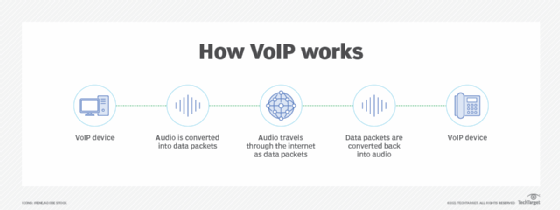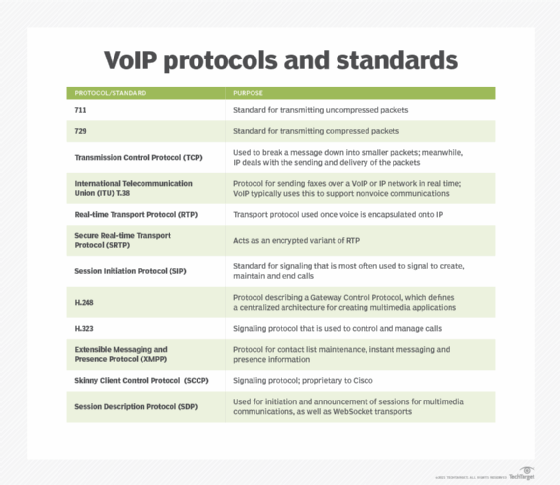VoIP phone
What is a VoIP phone?
A VoIP phone is a hardware- or software-based telephone designed to use voice over Internet Protocol (VoIP) technology to send and receive phone calls over an IP network. The phone converts analog telephony audio into a digital format that can be transmitted over the internet and converts incoming digital phone signals from the internet to standard telephone audio.
VoIP phones, also known as IP phones, include features and capabilities not found in traditional analog phones. They also have additional performance requirements because phone calls are placed over the internet instead of the legacy public switched telephone network (PSTN).
How does a VoIP phone work?
VoIP phones convert voice calls into digital signals that are transported through IP networks, such as the internet. VoIP phones may work through physical phones that use VoIP technology or as virtual phone software installed onto a computer or mobile device.
Several networking components are required to make VoIP phones work. Phones are assigned IP addresses through the Dynamic Host Configuration Protocol, which automatically configures the network and the VoIP parameters. A domain name system tracks the IP addresses to enable devices, such as IP phones, to connect to each other.
VoIP phones require several protocols to facilitate the delivery of voice communications over the internet. Scroll down to read about the different VoIP protocols and their purpose.
Types of VoIP phones
The two main types of IP phones are hardware-based and software-based phones. Many VoIP service providers offer both types.
Physically, a hardware-based VoIP phone resembles a traditional hard-wired or cordless telephone. These phones include physical features, such as a speakerphone or microphone, touchpad, and display hardware to show user input and caller ID. VoIP phones also feature call transfer, multiparty calling and support for multiple VoIP accounts. Some VoIP phones can transmit and receive image data during calls, so they are considered video telephones.
Software-based IP phones, also known as softphones, are virtual phone software clients installed on a user's computer or mobile device. The softphone user interface often resembles a phone handset, with a touchpad and caller ID display. A headset with a microphone that connects to the computer or mobile device is encouraged, or sometimes required, to make calls. Users can also make calls using their device if it includes a built-in microphone.
Softphone clients offer similar capabilities to hardware-based IP phones, such as voicemail, call conferencing and call transfer. Some clients may offer additional capabilities, such as video conferencing and instant messaging (IM).
Traditional analog phones may also be converted into IP phones by connecting to an analog telephone adapter (ATA). Analog phones can be converted by plugging the Ethernet network jack into the ATA, which then connects to the phone. The analog phone will connect to the internet rather than the PSTN, and it will appear to the phone system as a VoIP phone.
VoIP phone features
The main feature of a VoIP phone is that it enables voice calls to be made through the internet or other IP networks. VoIP phones may include other features and functionality, such as the following:
- video calling;
- IM;
- team chat;
- text messaging;
- online faxing;
- voicemail with speech-to-text transcription;
- records and logs of calls;
- Bluetooth communication with devices such as headsets, handsets, speakers and microphones;
- easy conference call access;
- auto attendant;
- mobile and desktop apps;
- mobile and local number portability that enables a subscriber to choose a new telephone carrier without needing a new number;
- call routing;
- call recording;
- call analytics; and
- integration with customer relationship management (CRM) and other software.
VoIP product features vary between offerings and vendors.
VoIP phone systems vs. traditional phone systems
VoIP phone systems differ from traditional phone systems, such as landlines and cellular phones, as they rely on IP networks rather than physical wiring to the PSTN network or cellular networks.
Compared to landline phone systems deployed on a similar scale, VoIP phone systems cost significantly less and include additional features beyond voice calling. However, as VoIP phones rely on IP networks, such as the internet, performance can be hindered by poor connections.
VoIP phone systems are also significantly cheaper than mobile phone systems deployed on a similar scale. While modern mobile phones may have many of the features included in VoIP phone systems, they generally lack enterprise-focused features, such as analytics, CRM and software integration.
Advantages of VoIP phones
VoIP phones offer organizations the following advantages:
- Cost savings. Organizations can reduce calling costs by switching to VoIP services. While traditional analog phones can have lower upfront costs, they are more costly to support, upgrade and integrate with communications applications. IP phones also offer less expensive long-distance and international calls, as VoIP phone calls are charged at the local rate of the call's destination.
- Performance. VoIP phones offer greater mobility and scalability than traditional handsets. If an organization moves to a new location, it does not need to acquire new phone lines, which it would with a traditional phone system. Adding new phones to a VoIP system is only limited by the available bandwidth on the organization's network. Softphones also provide increased mobility, as clients are not tied to physical locations like they would be with hard-wired phones.
- Integration. VoIP phones can also integrate with other business applications. For example, organizations can integrate their CRM software with VoIP phones to view call records and analytics for different customers and sales leads or to make phone calls straight from CRM applications.
Disadvantages of VoIP phones
VoIP phones, however, do have several disadvantages:
- Performance constraints. VoIP phones require a reliable internet connection and are susceptible to bandwidth constraints. With insufficient bandwidth, phone calls may experience latency, which can result in delays and dropped calls. Additionally, if an organization has a power or internet outage, users cannot make calls from their VoIP phones.
- Emergency calling. Emergency calls with VoIP phones can be difficult because IP addresses do not offer the exact location of callers, which makes it difficult for 911 operators to route VoIP phone calls to the appropriate emergency call center. VoIP providers are required by the Federal Communications Commission to support Enhanced 911 (e911), however, and may use third-party providers to meet that requirement.

VoIP ports
As VoIP phones use IP networks, such as the internet, data must go through a VoIP server. For VoIP servers listening to incoming traffic from VoIP phones, the industry standard is port 5060. Generally, this is configured as the default for VoIP phone services.
While this is the industry default, VoIP servers do not need to be configured to port 5060 and can be set to any random port. This can help avoid malicious attacks on VoIP servers, which generally target those connected to port 5060.
VoIP protocols
VoIP phones use the following technology standards and protocols:

H.323 is the most commonly used VoIP protocol that supports audio, video and data communications across IP networks. It provides several VoIP functions, including bandwidth management and call control.
For more in-depth information on how VoIP technology works and the history of VoIP, read our definition.
Read about how VoIP differs from IP telephony and how to configure it on a network.







